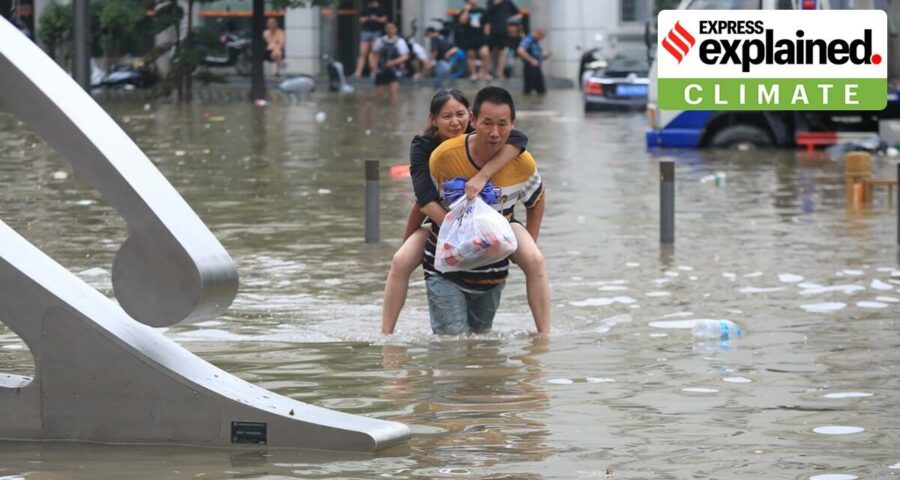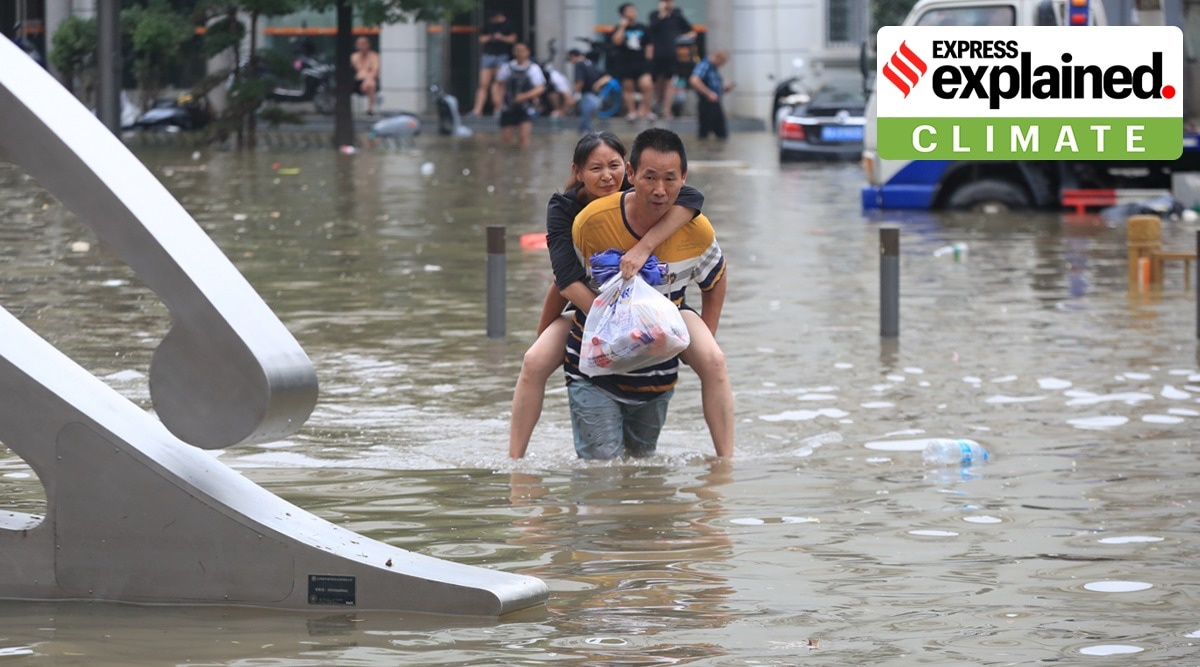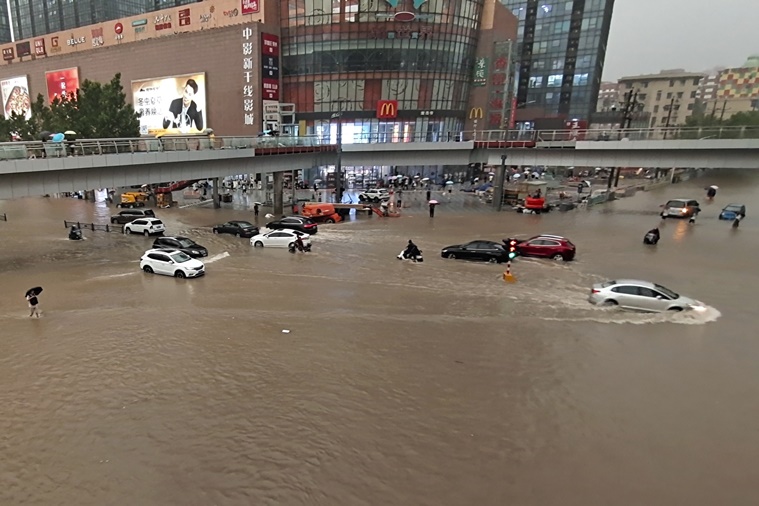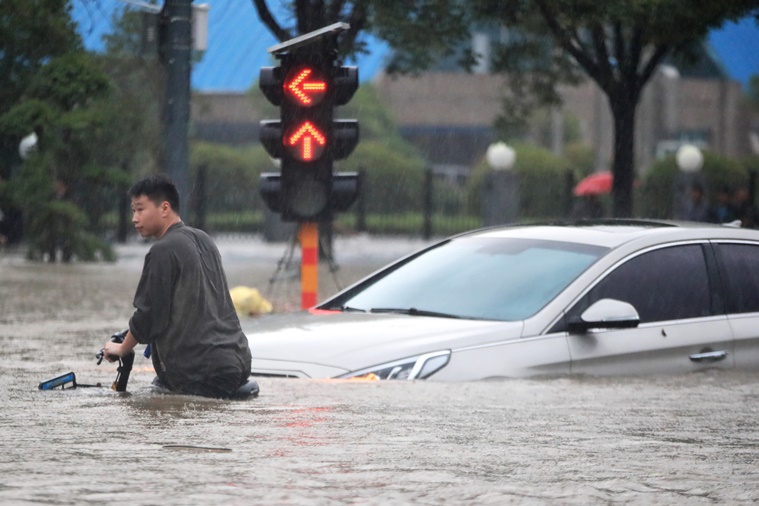China sees severe flooding every year, causing loss of life and property. However, over the years, the impact has worsened with climate change and rapid urbanisation.
Horrifying visuals of overturned cars and people trapped in flooded subways and streets of China have inundated social media in the past three days. A video by the China Xinhua News shows commuters in neck-deep water inside a metro line at the Zhengzhou city, which has a population of over 1.2 crore citizens, as they wait for rescuers to arrive.
At least 25 people, including 12 subway passengers, have been killed in the downpour so far, as China’s central Henan province witnesses its heaviest rainfall in a 1,000 years. Officials have stated that Zhengzhou recorded 617.1 mm rainfall from Saturday to Tuesday, nearly the same as the annual average rainfall in the city (640.8 mm).
According to state-run media, a total of 1.24 million people were affected by the flooding and as many as 1,60,000 were evacuated. Seven individuals have been reported as missing, while two were killed due to a wall collapse. Not just subways, streets, hotels, and a large number of buildings were waterlogged, bringing the city’s public transport to a halt. The Shaolin Temple, a sanctuary for Buddhist monks, has also been reportedly hit by severe floods.
Newsletter | Click to get the day’s best explainers in your inbox
The damage and the rescue efforts
As meteorologists predict more rain across the Henan province for the next three days, President Xi Jinping deployed as many as 5,700 People’s Liberation Army soldiers to the city, nearly 650 km southwest of Beijing, for search and rescue operations.
Visuals on CGTN show firefighters rescuing 150 children and staff from a school in the Zhengzhou city. While hospitals and schools have been cut-off, libraries, cinemas and museums have also turned into shelters for those stranded in the torrential rains. Reuters reported that the First Affiliated Hospital of Zhengzhou, the city’s largest with more than 7,000 beds, lost all power, prompting officials to arrange transport for nearly 600 critically ill patients.
On Wednesday, Xi took note of the “significant loss of life and damage to property.” The state media quoted him as saying that the rainfall has made the flood control situation very severe, with water levels in alarming levels in rivers and damages to dams. While sections of railways have been suspended, several flights have also been cancelled.
The downpour has led to the breach of several dams. Local authorities in the Luoyang city reported a 20-metre breach in the Yihetan dam, fearing it could collapse any time. On Tuesday night, the military blasted the dam to release the floodwaters. In Zhengzhou, the Guojiazui reservoir has been breached but there have been no reports of a dam failure yet.
The president ordered all authorities to organise flood relief forces and highlighted the need to minimise casualties as well as take care of hygiene and disease control to prevent epidemics.
What has caused the heavy flooding?
The South China Morning Post has reported that the incoming Typhoon In-Fa is responsible for the heavy rainfall. The typhoon, along with the air currents, has carried atmospheric water, concentrating at the Zhengzhou city, which is surrounded by the Taihang and Funiu mountains.
However, China’s flooding isn’t unprecedented. The country sees severe water-logging every year, causing loss of life and property. However, over the years, the impact has worsened with climate change and rapid urbanisation. As more of the land gets covered with impermeable concrete, the risk of water-logging at the surface increases. Last year, floods in the country left more than 200 people dead or missing and caused $25 billion in direct damage.
Zhengzhou city sits on the banks of the Yellow River, the second longest river in China, which is another reason why it’s harder to control floods in the area. The country has relied on man-made dams and reservoirs to mitigate flooding, but with extreme rainfall, the dams are unable to hold water. Officials in the past have also raised concerns over the strength of the Three Gorges Dam, the world’s biggest hydroelectric station, built on the Yangtze River, as rainfalls get heavier over the years.
According to Li Shuo, a climate analyst for Greenpeace East Asia, the floods “ring an alarm bell for China that climate change is here,” news agency AFP reported. Another expert, Benjamin Horton, director of the Earth Observatory of Singapore, stated that with global warming, the Earth’s atmosphere holds more moisture, resulting in heavier downpours.
Is the rest of the world seeing effects of climate change?
Climate change has caused extreme weather conditions all over the world. The western countries of US and Canada were hit by severe heat waves, resulting in heavy loss of life. Similarly, Jacobabad, located in the Sindh province of Pakistan, saw temperatures rising well above human tolerance, at a life-threatening 52 degrees Celsius.
Germany, too, saw devastating floods, killing at least 196 people in Western Europe. India witnessed back-to-back cyclones Tauktae and Yaas at its east and west coast, respectively. The monsoon, too, saw an advanced onset for at least half of the country, coming to a complete halt for states like Haryana, Punjab and Delhi, which witnessed severe heatwaves as they awaited rainfall. In fact, new research suggests that global warming is making India’s monsoon wetter and more dangerous.
Source: Read Full Article





